#Jew Food
Text
CHECK OUT THIS REALLY COOL BOOK ABOUT AFRICAN-JEWISH COOKING!!

Michael Twitty, the James Beard award-winning author of the acclaimed “The Cooking Gene”,explores the cultural crossroads of ✡️Jewish and African diaspora cuisine and issues of memory, identity, and food🥘.
To Twitty, the creation of African-Jewish cooking is a conversation of migrations and a dialogue of diasporas offering a rich background for inventive recipes and the people who create them.
The question that most intrigues him is not just who makes the food, but how the food makes the people. Jews of Color are not outliers, Twitty contends, but significant and meaningful cultural creators in both Black and Jewish civilizations.
“Koshersoul” includes 48-50 recipes.
#jewish#jewish resources#jumblr#jewish tumblr#gay jew#jewish lgbtq+#lgbtq+#food#history#recipes#book#i got a chance to see him in person and he is so sweet and so amazing#the recipes are also really good#but the real treasure is the history the book tells
7K notes
·
View notes
Text
I want to hear from as many Jews as possible on this one so reblogs for a larger sample size would be appreciated!
#jewblr#jumblr#jew tag#frumblr#i wanna reach as many jews as possible#jewish#jewish stuff#jewish conversion#judaism#kosher#jewish culture#jewish food#poll
1K notes
·
View notes
Note
Hello hello, sending hugs as always!
I was hoping you maybe be able to give me some inspiration for a small series of food photos I'm assembling for Channukah! I'm doing an 8 part series celebrating the different groups within Judaism to 1. Be loudly and proudly Jewish at this current time, and 2. raise awareness for non-ashki Jews. In the UK it's super hard to find many non ashki peeps which makes it hard to chat to people about other classic Channukah foods, but I was wondering if you knew of any particularly good ones (that aren't latke or sufganiyot)? Would hugely appreciate any suggestions you have!!
Hi darling, sending you the biggest hugs right back! <3
Oooh, Hanukkah foods! I'm not gonna lie, some of my fave Jewish foods come from this holiday. With your permission, I'll give a small introduction, just for anyone reading, who might be unfamiliar with Hanukkah, and curious... and also talk about some of the lesser known Hanukkah food traditions among European Jews, too.
So during Hanukkah, we celebrate a miracle that happened with the oil at the Temple in Jerusalem. After the Jews defeated the occupying Greek forces that had desecrated our Temple, we wanted to light again the eternal flame of the Menorah (the Temple candelabra) with olive oil, but after the destruction caused by the Greek forces, there was only enough left for one day, and it would take 8 days to get more oil. The miracle is that somehow, that small amount of oil lasted for the whole 8 days, meaning the light didn't go out again. To remember this miracle, we eat food fried in oil! Being Jewish is so good for your health. XD
In shops and bakeries around Israel, there are already sufganiot being sold. They are YUMMY, and while some people call them "the Jewish donuts," I can say that after having eaten American donuts, I def think sufganiot are way yummier (in part 'coz they're not as "heavy" because the dough it's made of is fluffier? More... airy? Not sure how to say it, but I hope you get the idea). Also, you don't get robbed, because someone made a hole in the middle of the sufgania, taking out nearly half of it. The traditional type has strawberry jam injected inside, and sugar powder on top, but in Israel there are some crazy fancy kinds, and every year they seem to become more extravagant.
Traditional sufganiot (you can see a bit of the jam on top, but half the fun is biting and getting to the "treasure" of lots of jam at the center of the sufgania):

Fancy sufganiot:


Then there's the latkes, or as they're called in Hebrew, levivot. They're like savoury pancakes made out of potatoes, and obviously they're fried in oil.
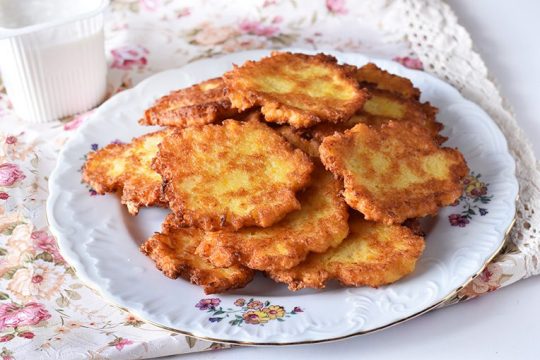
In many Jewish communities, there was a custom of giving kids special pocket money for Hanukkah. In Israel, this "money" is given in the form of chocolate "coins." I freaking loved this as a kid! It was fun unwrapping the "coins," eating the chocolate, and then (assuming I was careful when peeling them off), make a collection of the different "coins," or just play with the wrap.
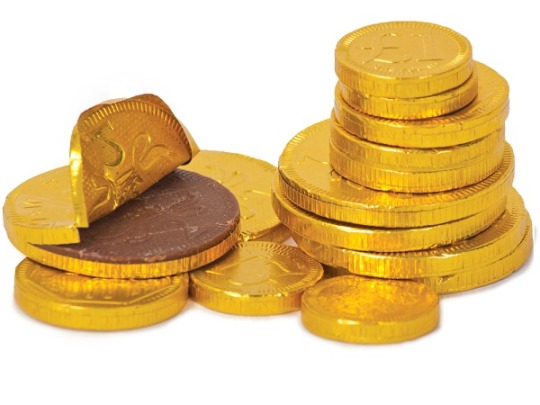
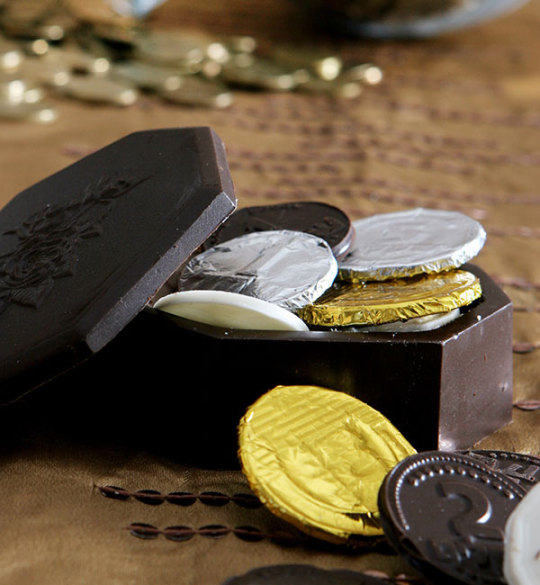
Greek Jews used to make a bread from potatoes and yogurt:

Georgian Jews made levivot out of corn flour (sometimes filled with cheese), or out of potatoes AND nuts, giving it the shape of a big omelette. Here's the corn flour version:
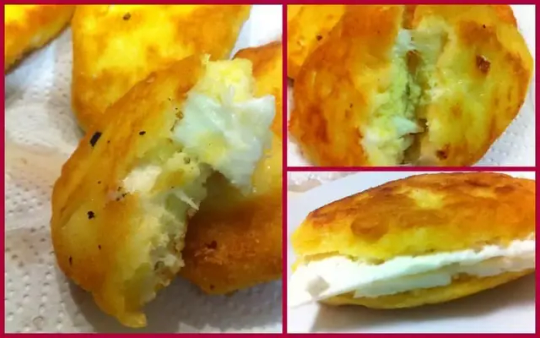
Czech Jews had a custom saying goose is the best meat, so for Hanukkah, they often ate goose related dishes. For example, they would make levivot from potatoes, eggs, sugar, lemon and goose fat.
French and Swiss Jews would make levivot out of apples.

The Jews of Iraq, Algeria and Buchara (which is in Uzbekistan) used to put the Hanukkah pocket money for the kids inside honey cakes. In Algeria and Buchara they also sometimes made levivot with meat added inside.
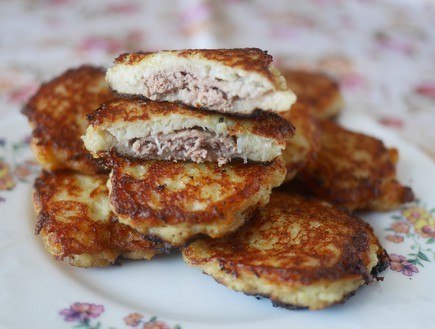
The Jews of Romania and Austria used to light potato Hanukkah candles! This was likely because they were so poor. Still, a pretty cool thing, when you can light your candle, and eat it (or at least a part of it), too.

In northern Africa, Jews used to make a type of cookie called Debla (sometimes nicknamed "dough roses"), which originated in Libya. They're usually eaten with a sweet syrup. It's more of a Purim dish (the equivalent of Hamantaschen), but was sometimes prepared for Hanukkah as well. Traditional Debla:
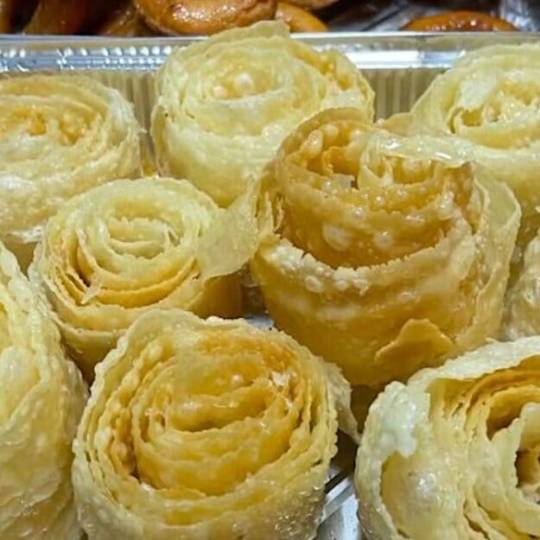
And a slightly "fancier" Israeli version:
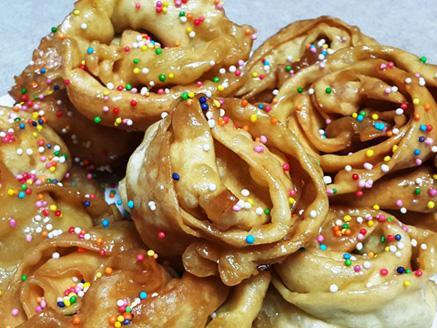
Okay, maybe my fave Hanukkah dish! It's called sfinge (the 'ge' is pronounced like in "sponge"), and it's basically the Moroccan sufgania, which later became popular among Tunisia and Libya Jews, too. It can be round with a hole in the middle, it can be in the shape of a ball, while Libyan Jews make it flat. It's eaten with either honey or sugar powder, but again, in Israel fancier versions developed... I'm not a great cook, so IDK to explain why, but it's even fluffier than the sufgania, and that's why it's my personal fave.
Traditional sfinge with honey:

With sugar powder:

Israelis always having to make everything fancier:

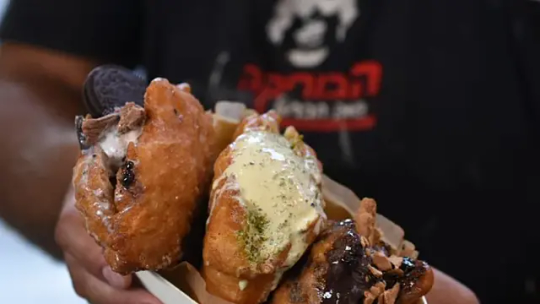


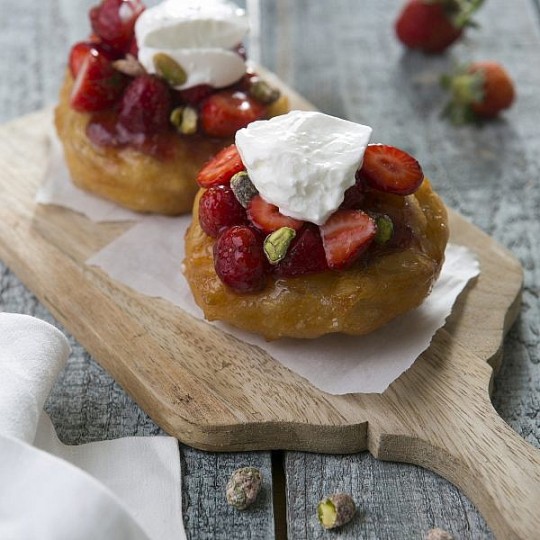

They even made a savoury version of flat sfinge...

I hope this helps! Have a wonderful day, darling! xoxox
#judaism#jewish#jew#jumblr#frumblr#ask#classical-memeician#jews#jewish stuff#hanukkah#jewish history#jewish food#foodgasm
343 notes
·
View notes
Text
So I know some people are going to hate me for being here, but whatever. I came to Israel just over a week ago to do volunteer work and let me tell you, as a Jew who lives in a place in the diaspora with very few other Jews, the amount of feeling at home and safe and *heard* (despite hearing the bang as Iron Dome worked on New Years Eve) has just been incredibly wonderful.
My husband and I are on this group trip doing volunteer work picking peppers and packing boxes for people displaced from their homes and I'm with other Jews and everywhere I turn there are other people who are *my* people!!!
#jewish#jumblr#am yisrael chai#israel#like actually tho#getting on the elal flight#i literally breathed a sigh of relief#i was with my people#i am with my people#seeing mezzuzot on the doors of everywhere#makes me sooooo happy#talking to other jews#jewish things#eating jewish food#bargaining in the markets#its the best#hearing hebrew and seeing it everywhere makes me so happy
341 notes
·
View notes
Text
Look what Google just recommended to me!!!!
I already own (and love) Shabbat and Portico.
But I am OBSESSED with the rest and must acquire them immediately.
Top of my list is Love Japan because LOOK AT THIS BEAUITFUL BOWL OF MATZO BALL RAMEN!!!!!

We hear a lot about Jewish people in Europe and MENA, but we do not hear a lot about Jewish culture as it blends with East Asian cultures, and that’s a shame. Not just because it erases the centuries of Jewish populations there, but also because there are plenty of people of mixed decent. People who may not have come directly from Jewish communities in East Asia, but people who have a Japanese Father and a Jewish Mother, for example. Or people in intercultural marriages. These are all real and valuable members of the Jewish community, and we should be celebrating them more. This cookbook focuses on Jewish Japanese American cuisine and I am delighted to learn more as soon as possible. The people who wrote this book run the restaurant Shalom Japan, which is the most adorable name I’ve ever heard. Everything about this book excites and delights me.
And of course, after that, I’m most interested in “Kugels and Collards” (as if you had any doubts about that after the #kugel discourse, if you were following me then).

This is actually written in conjunction with an organization of the same name devoted to preserving the food and culture of Jews in South Carolina!
I’m especially excited to read this one, because I have recently acquired the book Kosher Soul by the fantastic, inimitable Michael J. Twitty, which famously explores faith and food in African American Jewish culture. I’m excited to see how Jewish soul food and traditions in South Carolina specifically compare and contrast with Twitty’s writings.
I’m also excited for all the other books on this list!
A while ago, someone inboxed me privately to ask what I recommended for people to read in order to learn more about Jewish culture. I wrote out a long list of historical resources attempting to cover all the intricate details and historic pressure points that molded Jewish culture into what it is today. After a while I wrote back a second message that was much shorter. I said:
Actually, no. Scratch everything I just said. Read that other stuff if you want to know Jewish history.
But if you want to know Jewish culture? Cookbooks.
Read every Jewish cookbook you can find.
Even if you don’t cook, Jewish cookbooks contain our culture in a tangible form. They often explain not only the physical processes by which we make our meals, but also the culture and conditions that give rise to them. The food is often linked to specific times and places and events in diaspora. Or they explain the biblical root or the meaning behind the holidays associated with a given food.
I cannot speak for all Jews. No one can. But in my personal observation and experience—outside of actual religious tradition—food has often been the primary means of passing Jewish culture and history from generation to generation.
It is a way to commune with our ancestors. I made a recipe for chicken soup or stuffed cabbage and I know that my great grandmother and her own mother in their little Hungarian shtetl. I’ll never know the relatives of theirs who died in the Holocaust and I’ll never meet the cousins I should have had if they were allowed to live. But I can make the same food and know that their mother also made it for them. I have dishes I make that connect me to my lost ancestors in France and Mongolia and Russia and Latvia and Lithuania and, yes, Israel—where my relatives have lived continuously since the Roman occupation even after the expulsions. (They were Levites and Cohens and caretakers of synagogues and tradition and we have a pretty detailed family tree of their presence going back quite a long time. No idea how they managed to stay/hide for so long. That info is lost to history.)
I think there’s a strong tendency—aided by modern recipe bloggers—to view anything besides the actual recipe and procedures as fluff. There is an urge for many people to press “jump to recipe” and just start cooking. And I get that. We are all busy and when we want to make dinner we just want to make dinner.
But if your goal isn’t just to make dinner. If your goal is to actually develop an understanding of and empathy for Jewish people and our culture, then that’s my advice:
Read cookbooks.
#Judaism son#Jewish culture#Jewish cuisine#culinary tradition#culinary history#foodways#cultural preservation#tangible culture#jumblr#Judaism#food#cuisine#kugel discourse#Jewish joy#jewish positivity#Jews around the world#East Asian Jews
146 notes
·
View notes
Text
my trust in goyim is so broken. I don’t think it can ever be repaired. I can’t believe how much people hate Jews for no reason other than we exist and they dislike that.
#jumblr#chelsea speaks#fuck JVP#organization of white goy trying to make themselves feel better and taking advantage of jews#can’t believe i used to respect and trust them#this isn’t directed at jvp volunteers who are working in the food banks and donating medical supplies etc y’all are doing gods work#it’s directed at the goyim who run that org and use jews as mouthpieces and puppets
119 notes
·
View notes
Text
The Jewish mark on iconic Irish cuisine:
Corned Beef and Cabbage is a popular dish among Americans on St. Patricks Day. Traditionally, in Ireland, cabbage was and is paired with pork bacon.
However, during the 19th century, as Irish immigrants moved to the U.S., they discovered there was a lower-cost meat alternative to pork. It was their Jewish neighbors who introduced the cured meat and Kosher butchers to the community when they noticed some similarities in the two salty meats. Cooking the corned beef together with cabbage proved to be a low-cost and delicious solution; and the rest is history.

#irish#Irish antisemitism#antisemitism#israel#secular-jew#jewish#judaism#israeli#jerusalem#diaspora#secular jew#secularjew#islam#corned beef and cabbage#corned beef#cabbage#jewish history#lower East side#cuisine#food#Irish food#Irish cuisine#st patricks day#st pattys day
103 notes
·
View notes
Text

This really is how it is these days
105 notes
·
View notes
Photo


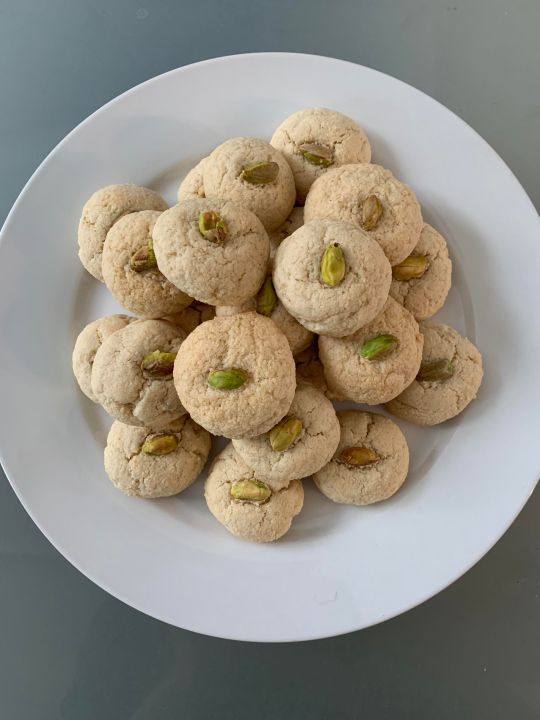

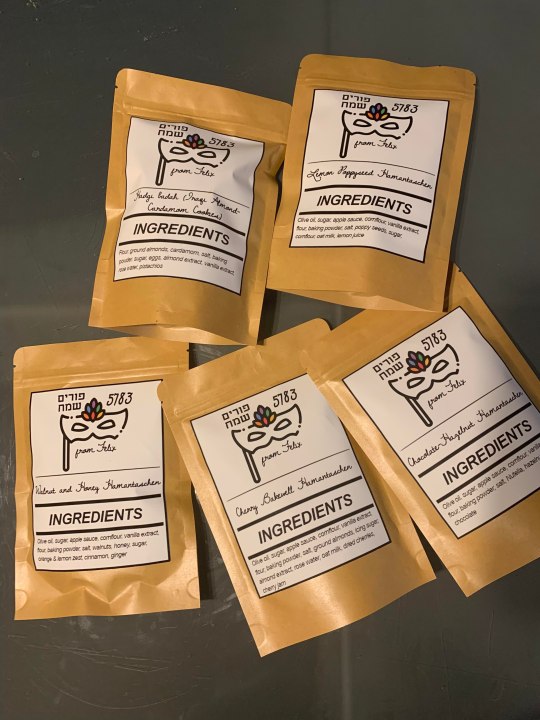

Purim Sameach!
!פורים שמח
I spent all weekend making my shalach manot and I’m well and truly exhausted. I set up a shalach manot exchange for my shul so I felt obligated to pull all the stops out.
The hamantaschen flavours are: Nutella, walnut and honey, Cherry Bakewell (cherry jam, homemade marzipan and dried cherries) and lemon and poppyseed (lemon curd filling with poppyseed dough). I felt like different flavours of hamantaschen didn’t really count as two different ‘portions’, so I also made hadgi badah, an Iraqi-Jewish almond & cardamom cookie. They were really easy to make and absolutely delicious, will definitely be making again.
And yes, I did make my own labels; I had leftover sticker paper from another project and I can never resist the opportunity to go a little bit overboard.
I’m really curious what other people put in their shalach manot! Please comment or reblog and tell me what you’re doing, especially with pictures.
#פורים#פורים שמח#purim#purim 2023#purim 5783#פורים 5783#hamantaschen#mishloach manot#shalach manot#queer jews#trans jews#judaism#jumblr#frumblr#jewish#jewish food
435 notes
·
View notes
Text
i actually find it funny that i posted about goyim's lack of being able to differentiate between Israel (country), Israel (land), and Israel (people) in jewish culture and discussion and anons insisted i was just a filthy zionist with a persecution complex complaining about nothing and then like (2) weeks later leftists are calling the shema zionist propaganda because of their lack of differentiation between Israel (country), Israel (land), and Israel (people) in jewish culture and discussion.
#g talks#it's almost like jews know what they're talking about when it comes to their own culture#and you should stop being a nazi fuck#food for thought#antisemitism#mine#/mobile#/okay to reblog
110 notes
·
View notes
Text
Something that strikes me as I'm planning on hosting some visiting relatives (BTW if I have any New Zealand followers can you please reblog or comment with details about what type of tea is considered standard or a little better than average in New Zealand?) is how much comfort and joy I've given vegetarian and vegan travelers in the past by just serving them some good tasty normal calorie levels vegetarian/vegan food, as unfortunately that can be hard to come by as a traveler in the US and so several of the people I've hosted were obviously running a calorie deficit because they were struggling to find enough food suitable to their diet.
And, I am not vegetarian! I'm low-key ideologically Not vegetarian! But I also believe that 1. It's immoral to intentionally trick someone else into violating their own morals even if you don't share them and 2. Hospitality means serving people good food that they like and can eat.
I've gotten a lot of shocked responses from people in the past when I would say something like, "This recipe can be made vegetarian/vegan if you swap the meat broth with vegetable broth/swap the cheese for vegan cheese or omit it" and then they'd assume that I must be vegetarian/vegan myself, and not understand why I would care about tracking which recipes could be vegetarian or consider it a valuable thing. Other people have dietary restrictions and sometimes I want to make them something nice to eat! It's shitty hosting to invite someone to Thanksgiving and then have like two things out of twenty they can eat, you know?
#food#original post#vegetarian#vegan#hospitality#cooking#also meat is expensive and I don't always have a lot of money#good rice and beans dishes have multiple utilities#politeness#the same principle applies to other dietary restrictions#I've ordered a lot of pizza for groups containing jews or muslims#guess what#my standard group pizza order is pork free
84 notes
·
View notes
Text
And yeah. I will block any leftist on here I see engaging with any of my posts or reblogs about I/P who have stuff on their blogs endorsing the slaughter of civilians and children as “de-colonization.”
#we Jews see you cheering for our murdered children#and we know you’d be the exact same as those people who gladly provided goods and services and food to the officers and guards of the camps#in Germany and Eastern Europe#my commie Jewish ass has no time for those subscribing to the socialism of fools#thoughts of a Jewish decepticon
93 notes
·
View notes
Text
Yo! Jewish people! My guys! Happy Chanukkah! Don't let those damn antisemites ruin your latke eating!
💛
#jewish#jews#am israel hai#war#ישראבלר#jumblr#antisemitism#frumblr#chanukah#nom nom nom#jewish food#is so great#ahhhhh
62 notes
·
View notes
Text

#just curious#i have eaten it and it is very yummy#lol#polls#judaism#jewish food#food#jumblr#non jews feel free to respond and reblog#this is the answer btw stop reading if you haven't responded yet#its yerushalmi kugel
79 notes
·
View notes
Text
I went in to the local kosher shop and asked that since purim is over when do they get their pesach stock in. The evil looks I got from all the Jewish mothers in there makes me feel like I can never go back. I'm sorry I just love pesach it's whimsical
24 notes
·
View notes
Text
The Truth about Aid Flowing into Gaza. By Barry Shaw: The View from Israel
As Melanie Phillips aptly put it,
"In the remorseless attempt to demonise Israel, humanitarian aid has become the blood libel of the day."
Israel says there is no limit to the number of aid trucks being allowed into Gaza. The hold-ups at the crossing points are because the UN is struggling to distribute the aid.
That is because it uses the UN’s Palestinian refugee agency UNRWA, which is controlled by Hamas.
Israel's COGAT says that, over the past two weeks, almost 50% more food trucks have entered Gaza than before the start of the war.
On Wednesday, 257 trucks entered. Over the past few days, more than 100 trucks were transferred to the northern part of the Strip. Over the past two weeks, the number of operational bakeries in Gaza doubled from 10 to 20, providing more than 2.5 million breads per day to the population.
From the start of the war, more than 750 packages of humanitarian aid have been delivered by 25 airdrops mounted by an alliance of Israel, the US, the UAE, Egypt, Jordan and France. None from Britain!
The media is showing a deeply biased, deliberately selective, picture of Gaza.
COGAT, which co-ordinates Israeli government activities in Judea, Samaria and Gaza, published a video of Gazans queuing up at a plentiful shawarma stand in Rafah.
Social media footage has shown well-stocked Rafah markets. There have also been videos of Gazans contemptuously throwing air-dropped ready-to-eat meals into the trash.
Hamas hijacks the trucks and steals the food and other supplies, either for itself or to sell to the population on the black market.
On social media, there are videos of aid trucks being commandeered by armed men. There are also videos of Egyptian drivers warning others not to drive aid trucks into Gaza because they are being attacked with rocks hurled through their windscreens, leaving some badly injured and even killed.
This has nothing to do with Israel.
It has everything to do with the impotence of the UN and other international aid organisations that have been in Gaza for decades.
Even US officials are admitting that Hamas is stealing the aid that the Biden administration is falsely accusing Israel of failing to provide.
One senior official told journalists that the problem was with distribution once the 250 to 300 truckloads of assistance got into Gaza. He said: “This is a product of, if you will, commercialisation of the assistance; criminal gangs are taking it, looting it, reselling it. They’ve monetised humanitarian assistance. … The food is there; it’s coming in”.
David Satterfield, the senior US diplomat involved in humanitarian assistance for Gaza, acknowledged that police escorts for aid deliveries include Hamas members, and that Hamas has been using other aid delivery channels to “shape where and to whom assistance goes.”
Israel is being scapegoated for the war crimes of Hamas. Scapegoating the Jews is the consistent and defining motif of antisemitism through the ages.
Israel’s media spokesman Eylon Levy said this week: “We will accept being scapegoated no longer.” Israel isn’t on its knees. The Jews of Britain and America should get up from theirs and publicly tell Cameron and Blinken the same thing.
#israel#secular-jew#jewish#judaism#israeli#jerusalem#diaspora#secular jew#secularjew#islam#blood libel#gaza#food aid#gaza aid#Hamas war#israel hamas war#hamas war crimes#Iran war crimes#Iran is Hamas#Hamas is Isis#egypt
98 notes
·
View notes